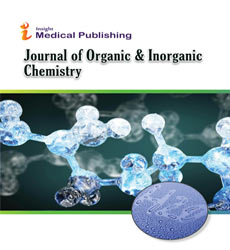Heterocyclic Scaffolds in Medicinal Chemistry: Structure, Reactivity, and Biological Potential
Meena Krishnan
Department of Inorganic and Physical Chemistry, Indian Institute of Science, Bangalore, India
Published Date: 2025-02-28DOI10.36648/2472-1123.11.1.123
Received date: February 03, 2025, Manuscript No. ipjoic-25-20811; Editor assigned date: February 05, 2025, PreQC No. ipjoic-25-20811 (PQ); Reviewed date: February 17, 2025, QC No. ipjoic-25-20811; Revised date: February 22, 2025, Manuscript No. ipjoic-25-20811 (R); Published date: February 28, 2025, DOI: 10.36648/2472-1123.11.1.123
Citation: Krishnan M (2025) Heterocyclic Scaffolds in Medicinal Chemistry: Structure, Reactivity and Biological Potential. J Org Inorg Chem Vol.11 No.1: 123.
Introduction
Heterocyclic compounds form the backbone of modern medicinal chemistry, representing some of the most versatile and bioactive scaffolds in drug discovery. Characterized by rings containing at least one atom other than carbon-commonly nitrogen, oxygen, or sulfurâ??these structures exhibit unique physicochemical and biological properties. Their structural diversity and reactivity render them indispensable in the development of therapeutic agents ranging from antibiotics and antivirals to anticancer and anti-inflammatory drugs. The prominence of heterocyclic scaffolds in pharmaceuticals stems from their ability to mimic natural biomolecules, engage in hydrogen bonding, and interact with biological targets such as enzymes and receptors. More than half of all marketed drugs incorporate a heterocyclic core, highlighting their pharmaceutical relevance. The ability of heterocycles to modulate lipophilicity, solubility, and electronic distribution makes them key determinants in optimizing pharmacokinetic and pharmacodynamic properties [1].
Description
Heterocyclic scaffolds encompass a wide variety of structural motifs, from simple five- and six-membered rings to complex fused polycyclic systems. Examples include pyridine, imidazole, indole, thiazole, and quinoline. Their substitution patterns and ring fusion possibilities create a nearly limitless library of derivatives. This structural diversity enables medicinal chemists to tailor molecular frameworks to specific biological functions, enhancing selectivity and potency. The presence of heteroatoms significantly alters the electronic distribution of heterocycles, influencing reactivity and binding interactions. Nitrogen atoms, for instance, can act as hydrogen bond donors or acceptors, increasing the affinity of compounds for biological macromolecules. Steric effects introduced by substituents further modulate receptor binding and metabolic stability. These tunable parameters allow chemists to optimize heterocyclic scaffolds for therapeutic applications [2].
The chemical reactivity of heterocyclic scaffolds underpins their synthetic versatility. Electrophilic and nucleophilic substitutions, metal-catalyzed cross-coupling, and cycloaddition reactions facilitate the generation of diverse analogues. Additionally, heterocycles serve as key intermediates in multicomponent reactions, enabling rapid assembly of complex bioactive molecules. Advances in green chemistry and microwave-assisted synthesis have further streamlined heterocyclic functionalization, enhancing efficiency and sustainability [3].
Nitrogen heterocycles dominate medicinal chemistry due to their prevalence in natural products and biomolecules. Indoles, for example, form the basis of serotonin and melatonin analogues, while pyrimidines are central to nucleic acid metabolism. Benzimidazole derivatives display potent antiulcer and antimicrobial activity, whereas imidazole derivatives serve as antifungal and antihypertensive agents. Their broad spectrum of pharmacological activities underscores their therapeutic importance [4].
Oxygen and sulfur heterocycles also exhibit remarkable biological potential. Coumarins, chromones, and oxazoles display anticoagulant, anti-inflammatory, and anticancer properties. Thiazoles and thiophenes, by contrast, are incorporated into antibiotics like penicillin and antidiabetic drugs such as pioglitazone. The incorporation of oxygen or sulfur atoms into scaffolds often enhances lipophilicity and redox activity, key features in modulating bioactivity. Complex fused heterocyclic systems, such as quinolines, purines, and isoquinolines, are particularly significant in oncology and infectious disease therapy. Quinolines, for instance, underpin antimalarial drugs like chloroquine, while purine analogues are widely used in antiviral therapies. The polycyclic nature of these scaffolds provides a rigid framework that enhances target specificity and minimizes off-target interactions. Recent advances in computational chemistry and molecular docking have revolutionized the design of heterocyclic drugs [5].
Conclusion
Heterocyclic scaffolds remain central to the evolution of medicinal chemistry, offering structural diversity, tunable reactivity, and vast biological potential. Their ability to interact with biomolecular targets and their versatility in synthesis make them indispensable in drug design and development. Continued innovation in heterocyclic chemistry will not only drive the discovery of next-generation therapeutics but also shape the future of sustainable and precision medicine.
Acknowledgement
None.
Conflict of Interest
None.
References
- Fu S, Liu J, Li C, Wei J, Yue H, et al. (2023). Structure-based drug design, synthesis and biological evaluation of novel 1, 3, 5-triazine or pyrimidine derivatives containing benzoyl hydrazine moiety as PI3Kα selective inhibitors. Bioinorg Chem140: 106738.
Google Scholar Cross Ref Indexed at
- Li Y, Liu Y, Zhang D, Chen J, Yang G, et al. (2023). Discovery, synthesis and evaluation of novel dual inhibitors of a vascular endothelial growth factor receptor and poly (Adp-ribose) polymerase for brca wild-type breast cancer therapy. J Med Chem66: 12069-12100.
Google Scholar Cross Ref Indexed at
- Liu L, Zhang L, Chen X, Yang K, Cui H, et al. (2023). Design and synthesis of 1H-benzo [d] imidazole selective HDAC6 inhibitors with potential therapy for Multiple Myeloma. Eur J Med Chem261: 115833.
Google Scholar Cross Ref Indexed at
- Kumari P, Ghosh S, Acharya S, Mitra P, Roy S, et al. (2023). Cytotoxic imidazolyl-mesalazine ester-based Ru (II) complexes reduce expression of stemness genes and induce differentiation of oral squamous cell carcinoma. J Med Chem66: 14061-14079.
Google Scholar Cross Ref Indexed at
- Kapitza P, Scherfler A, Salcher S, Sopper S, Cziferszky M, et al. (2023). Reaction behavior of [1, 3-diethyl-4, 5-diphenyl-1 h-imidazol-2-ylidene] containing gold (i/iii) complexes against ingredients of the cell culture medium and the meaning on the potential use for cancer eradication therapy. J Med Chem66: 8238-8250.
Open Access Journals
- Aquaculture & Veterinary Science
- Chemistry & Chemical Sciences
- Clinical Sciences
- Engineering
- General Science
- Genetics & Molecular Biology
- Health Care & Nursing
- Immunology & Microbiology
- Materials Science
- Mathematics & Physics
- Medical Sciences
- Neurology & Psychiatry
- Oncology & Cancer Science
- Pharmaceutical Sciences
